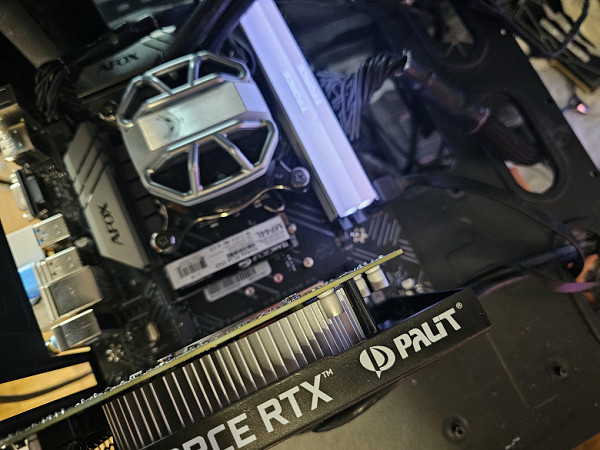Introduction
Motherboards on 6xx and 7xx series chipsets support three generations of Intel processors: 12th, 13th and 14th. This explains the constant interest of consumers in models designed for the LGA1700 socket. Mid-budget and inexpensive motherboards on the H610, B660 and B760 chipsets are especially in demand. Today we will look at one of the most affordable motherboards on the B760 chipset.
Recall that the Intel B760 chipset offers 14 PCIe lanes: 10 PCIe 4.0 lanes and 4 PCIe 3.0 lanes, which is half as much as the Z790. It also supports up to 4 SATA ports, up to 2 integrated USB 3.2 Gen2x2 (up to 20 Gbps), up to 4 USB 3.2 Gen2 (10 Gbps) and 6 USB 3.2 Gen1 (5 Gbps), and up to 12 USB 2.0 ports.
The 12th, 13th, and 14th generation processors add 20 PCIe lanes, including 16 PCIe 5.0 lanes for PCIe x16 slots and 4 PCIe 4.0 lanes for the M.2 slot. These processors support both DDR5 and DDR4, allowing motherboard manufacturers to release models with different types of memory.
Today, we are reviewing a motherboard from a small Chinese company, Afox Corporation. The products of this company are known for their simplicity and minimalism, which makes them more affordable compared to competitors. The range of connected devices on these boards is minimal, and there are often no multiplexers for dividing resources between ports or slots. But is such savings worth your money? Let's figure it out.
The main hero of today's review is the Afox B760D4-MA-V2.
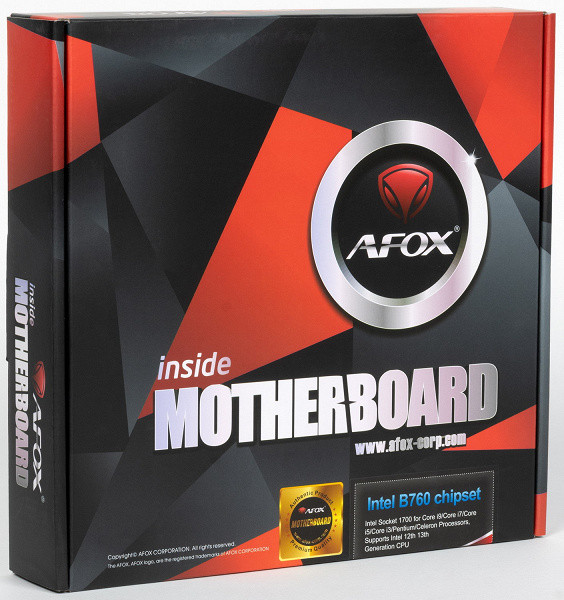
The Afox B760D4-MA-V2 motherboard comes in standard packaging with Afox's signature design. Inside the box, the components are located in a separate compartment next to the board.
The package is minimal: in addition to traditional elements such as a user manual and SATA cables, the package also includes a software disc and a rear bracket for installation on the case.

The software is provided on an outdated CD, but there is nothing exclusive on it: all the necessary drivers can be downloaded from the Intel website.
Please note that the rear panel plug with connectors is not installed on the board, but is included separately.
Form factor
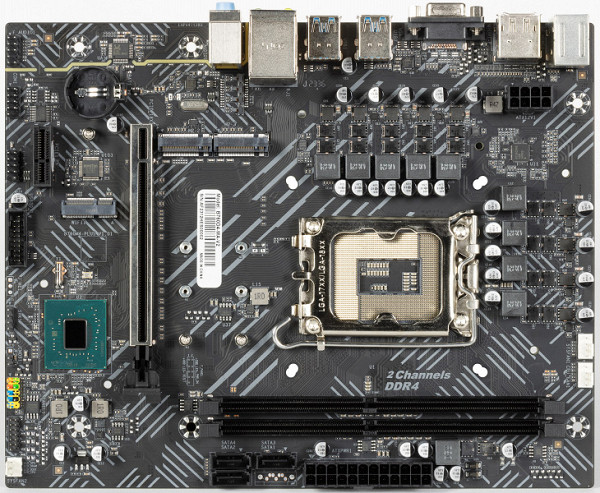

The Mini-ITX form factor has dimensions of 170x170 mm, Micro-ATX — up to 244x244 mm, ATX — up to 305x244 mm, and E-ATX — up to 305x330 mm. The Afox B760D4-MA-V2 motherboard is made in the Micro-ATX format with dimensions of 244x190 mm and is equipped with 6 mounting holes for fastening in the case.

The back side is practically empty. The textolite is well processed: sharp ends are cut off at all soldering points. There is no protective plate (backplate).
Technical specifications
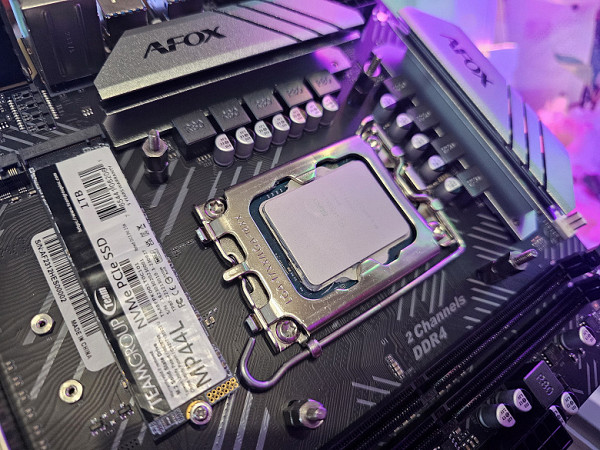
Traditional table with a list of functional features.
| Supported Processors | Intel Core 12/13/14th generation |
|---|---|
| Processor socket | LGA 1700 |
| Chipset | Intel B760 |
| Memory | 2×DDR4, up to 3600MHz, up to 64GB, dual channels |
| Audio subsystem | 1×Realtek RTL897 (5.1) |
| Network controllers | 1×Realtek RTL8111H Ethernet 1.0Gbps |
| Expansion slots | 1×PCIe 4.0 x16 (x16 mode) 1×PCIe 4.0 x1 1×M.2 (Key E) for wireless modules |
| Storage connectors | 3×SATA 6Gb/s (B760) 1×M.2 (M.2_1, CPU, PCIe 4.0 x4 for 2242/2260/2280 devices) 1×M.2 (M.2_2, B760, PCIe 4.0 x4/SATA for 2242/2260/2280 devices) |
| USB ports | 2×USB 2.0: 1 x 2-port internal header (B760) 2×USB 2.0: 2 x Type-A ports (black) on the rear panel (B760) 4×USB 3.2 Gen1: 4 x Type-A ports (blue) on the rear panel (B760) 2×USB 3.2 Gen1: 1 x 2-port internal header (B760) |
| Rear panel connectors | 4 × USB 3.2 Gen1 (Type-A) 2 × USB 2.0 (Type-A) 1 × RJ-45 3 x mini-jack audio 2 x PS/2 keyboard and mouse 1 x HDMI out 1 x Display Port out 1 x d-Sub (VGA) out |
| Other internal elements | 24-pin ATX power connector 1 8-pin EPS12V power connector 1 M.2 (E-key) slot for wireless network adapter 1 connector for connecting 2 USB 3.2 Gen1 ports 1 connector for connecting 2 USB 2.0 ports 3 connectors for connecting 4-pin fans and JSO pumps 1 Audio connector for connecting to the front panel of the case 2 connectors for connecting the control adapter from the front panel of the case 1 COM port connector 1 TPM connector for connecting security devices |
| Form factor | Micro-ATX (244×190 mm) |
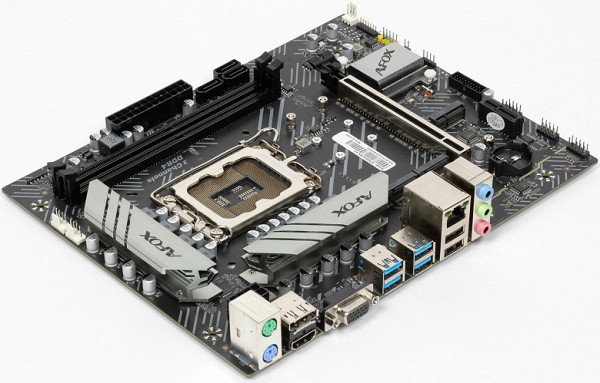
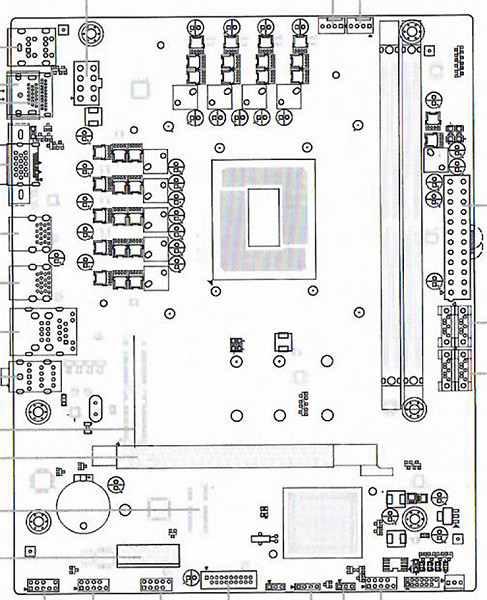
Scheme of operation of the chipset+processor bundle.
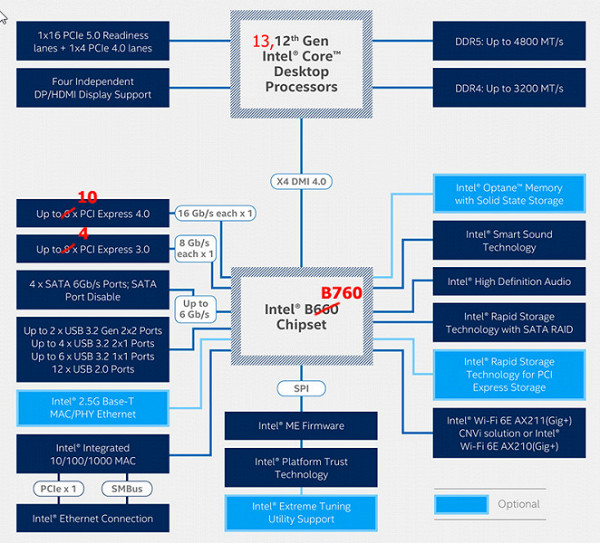
Formally, the motherboard supports DDR4 memory up to 3200 MHz, although in practice higher frequencies can be used via XMP profiles. However, in this model, support is limited to 3200 MHz.
The 12th/13th/14th generation Intel Core processors for the LGA1700 socket provide 20 I/O lines (16 PCIe 5.0 and 4 PCIe 4.0) and do not have built-in USB and SATA ports. Communication with the B760 chipset is carried out via the Digital Media Interface 4.0 channel (DMI 4.0 x4). All PCIe lines of the processor are directed to the PCIe expansion slots and the M.2 port. Serial Peripheral Interface (SPI) is used to interact with UEFI/BIOS, and the Low Pin Count (LPC) bus is designed to connect peripherals with low bandwidth requirements, such as fan controllers and TPM.
The B760 chipset supports up to 24 I/O lanes, distributed as follows:
- Up to 12 USB ports (including up to 2 USB 3.2 Gen2x2 ports, 4 USB 3.2 Gen2 ports, up to 6 USB 3.2 Gen1 ports, and up to 12 USB 2.0 ports; USB 2.0 ports also support USB 3.2, and each USB 3.2 Gen2x2 port requires support for two USB 3.2 Gen2).
- Up to 4 SATA 6Gbps ports.
- Up to 14 PCIe lanes (4 x 3.0 lanes and 10 x 4.0 lanes).
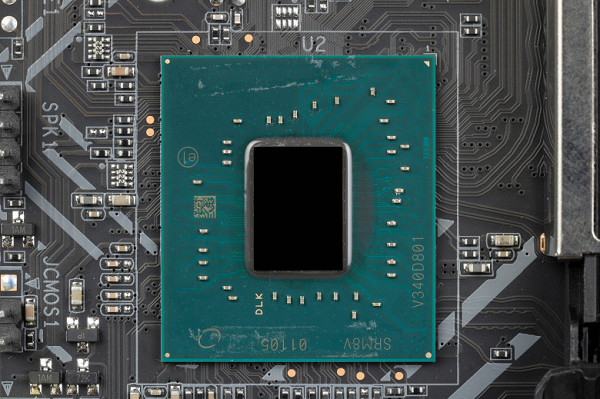
Afox B760D4-MA-V2 supports 12/13/14th generation Intel Core processors, designed for the LGA1700 socket.
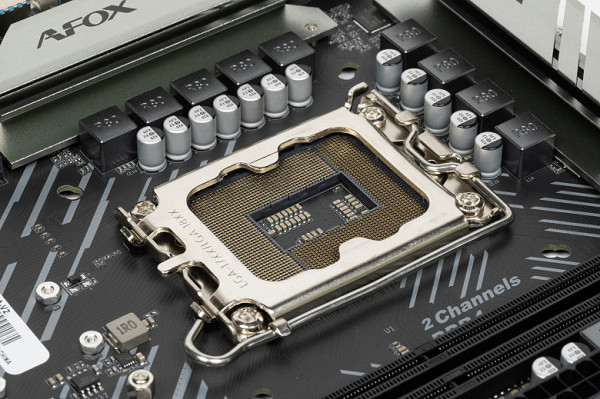
The Afox board has 2 DIMM slots for installing memory modules. The board supports unbuffered DDR4 (non-ECC) memory, and the maximum memory capacity is 64 GB.
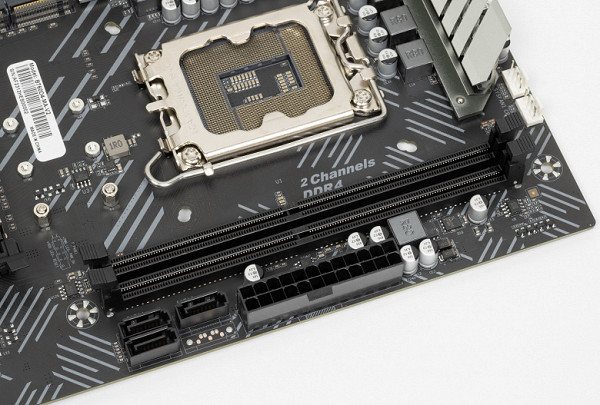
DIMM slots do not have a metal frame to protect them from physical damage or interference.
Peripheral functionality: PCIe, SATA, various additional devices
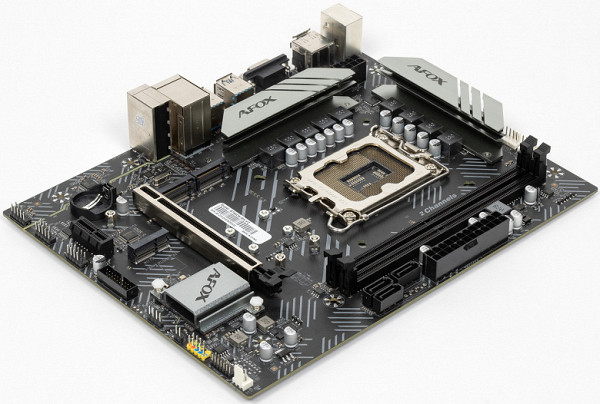
Let's see how the capabilities of the B760 chipset and Core processors are implemented on the Afox B760D4-MA-V2 motherboard.
The B760 chipset provides 14 PCIe lanes and 4 SATA ports. Let's see how these lanes are distributed:
- PCIe x1 slot: uses 1 PCIe 4.0 lane.
- M.2_2 slot: uses 4 PCIe 4.0 lanes.
- M.2 slot (key E): uses 1 PCIe 3.0 lane.
- Realtek RTL8111H (Ethernet 1.0 Gbps): uses 1 PCIe 4.0 lane.
So, out of 14 PCIe lanes of the chipset, 7 lanes (6 PCIe 4.0 and 1 PCIe 3.0) are occupied by various components, and the SATA_1/2/3 ports are also connected. In total, 10 HSIO (High-Speed I/O) are spent. The RTL4xxx audio codec is connected to the chipset via HDA, without using USB lines. One USB 2.0 port is used to support Bluetooth if the M.2 slot (key E) is installed.
The 12/13/14th generation processors have 20 PCIe lanes: 4 of them (PCIe 4.0) go to the M.2 port (M2_1), and the remaining 16 lanes (downgraded to PCIe 4.0) are directed to one PCIe x16_1 slot. Therefore, in this configuration, there are no options for switching or using multiplexers for the PCIe lanes.
As for the PCIe slots on the motherboard, there are two of them: one PCIe x16 for video cards or other devices, connected to the processor, and one PCIe x1, connected to the B760 chipset.
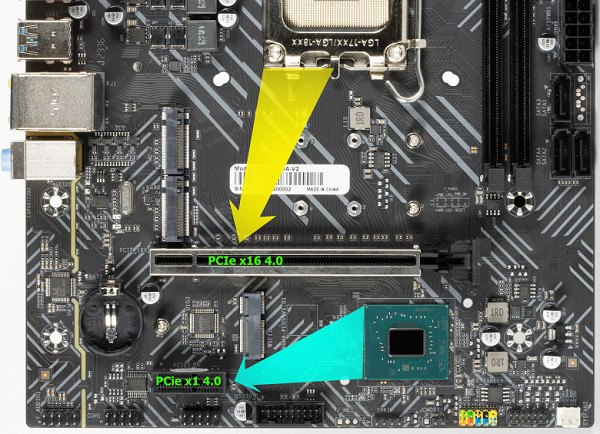
The first PCIe x16 slot for the processor is equipped with stainless steel metal reinforcement, which not only increases its strength, but also protects it from electromagnetic interference.

The motherboard allows you to mount a cooling system of any size.
Next in line are storage devices.
The board has a total of 3 Serial ATA 6 Gbps connectors + 2 slots for storage devices in the M.2 form factor.
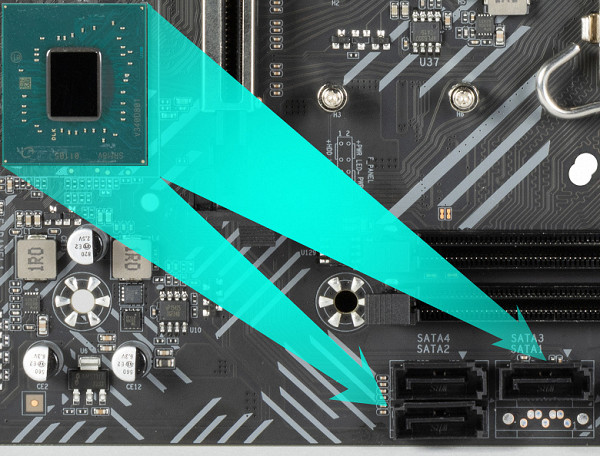
SATA ports are implemented via the B760 chipset and support RAID creation. They are placed in a vertical orientation.
The motherboard has 2 M.2 form factor slots.
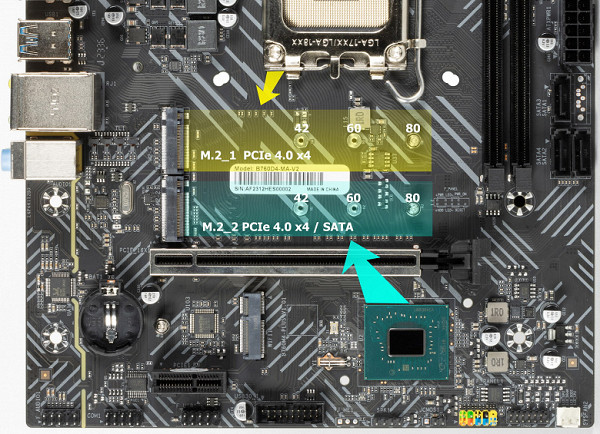
The first M.2_1 slot connects directly to the processor and supports the PCIe 4.0 interface. It is compatible only with PCIe modules and supports sizes 2242, 2260, and 2280. The second M.2_2 slot is connected to the B760 chipset, also uses PCIe 4.0, and supports modules with any interface, including sizes 2242, 2260, and 2280.
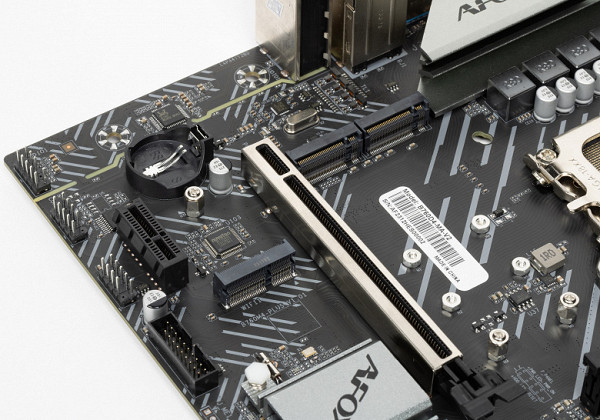
RAID can be organized on all M.2.
All M.2 slots are without cooling.
Peripheral functionality: USB ports, network interfaces, input/output
Now it's the turn of USB ports and other inputs and outputs. And let's start with the back panel, where most of them are located.

The B760 chipset supports up to 12 USB ports, including up to 6 USB 3.2 Gen1 ports, up to 4 USB 3.2 Gen2 ports, up to 2 USB 3.2 Gen2x2 ports, and up to 12 USB 2.0 ports.
Of the 14 PCIe lanes and 4 SATA ports available for connecting drives and controllers, 10 lanes are already allocated (as described earlier).
The motherboard has 10 USB ports, but no USB 3.2 Gen2x2 or 3.2 Gen2 ports. Specifically,
- 6 USB 3.2 Gen1 ports are provided on the rear panel (4 blue Type-A ports) and 2 more ports via an internal connector.
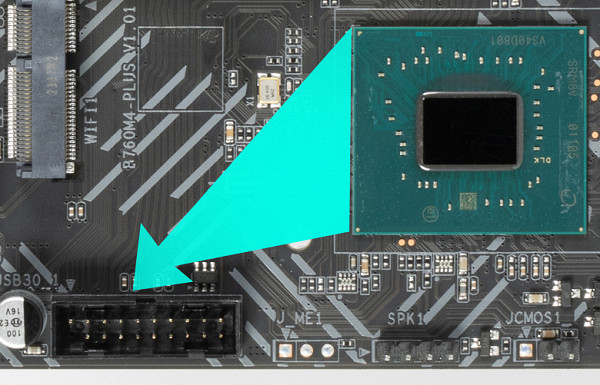
on the motherboard for 2 ports;
- 4 USB 2.0/1.1 ports: all implemented via B760 and presented on the rear panel by 2 Type-A ports (black); another 2 are represented by an internal connector

on the motherboard for 2 ports.
So we have only 1 controller using the USB lines: the M.2 slot (Key E for wireless) (1 USB 2.0 line).
As a result, the B760 chipset implements the following high-speed USB ports:
- 0 USB 3.2 Gen2 ports
- 6 USB 3.2 Gen1 ports
This gives 6 high-speed ports. Since each high-speed USB port also has its own USB 2.0 port, of these 6 ports, 6 USB 2.0 ports are already occupied. In addition, 4 dedicated USB 2.0 ports and 1 port for controller support are added. In total, 11 USB ports are implemented.
There are also 10 HSIO lines (for PCIe lines and SATA ports), which are used to connect other peripherals.
So, based on the B760 chipset, 16 high-speed ports out of a possible 24 are implemented.
Now let's move on to the network characteristics.

The motherboard is equipped with communication means very modestly. There is an Ethernet controller Realtek RTL8111H, capable of operating at the 1 Gbit/s standard.

There is no integrated wireless adapter in the kit, but there is an M.2 (E-key) slot for installing it (the adapter is purchased separately).
The rear panel cover is supplied separately from the main package.
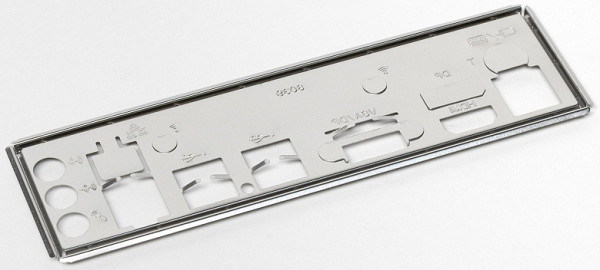
Audio subsystem
In this board, the sound is handled by an outdated and cheap audio codec from Realtek ALC897.
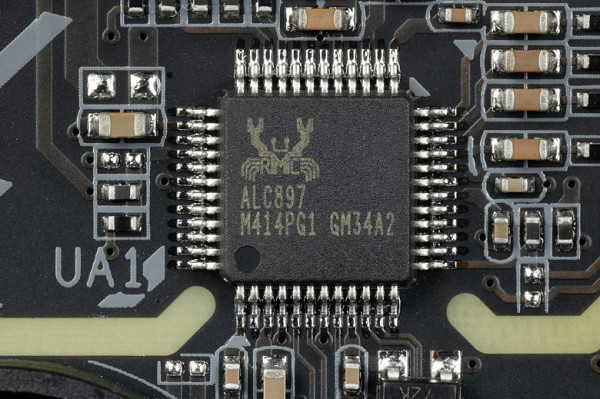
The audio track lacks an operational amplifier, DAC, and «audiophile» capacitors.
The audio part of the board is located in the corner area and does not intersect with other components. All audio connectors on the rear panel are painted in standard colors. There are no S/PDIF outputs.
Power, cooling
To power the board, it has 2 connectors: in addition to the 24-pin ATX, there is also an 8-pin EPS12V.
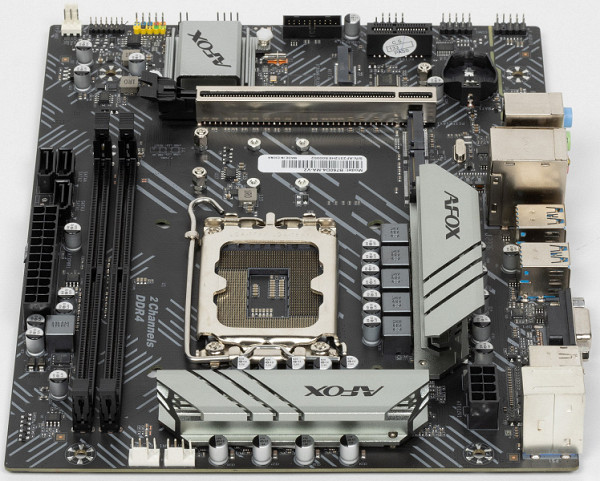
The processor power supply circuit is designed according to the 1+7+1 scheme (9 phases in total, 7 on VCore, 1 on iGPU and 1 on VCCIO).
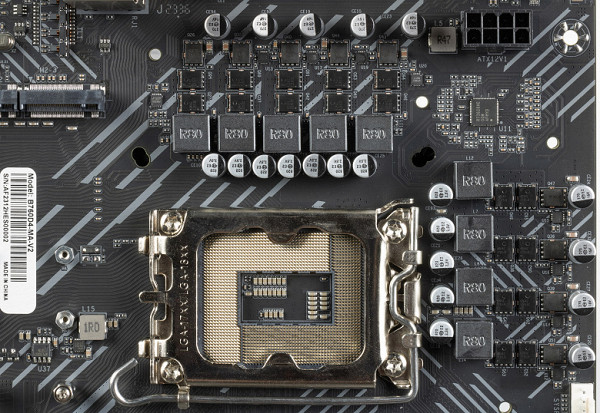
Each phase channel has a set of Xsemi XP4064CMT/XP4062CMT 58A MOSFETs.
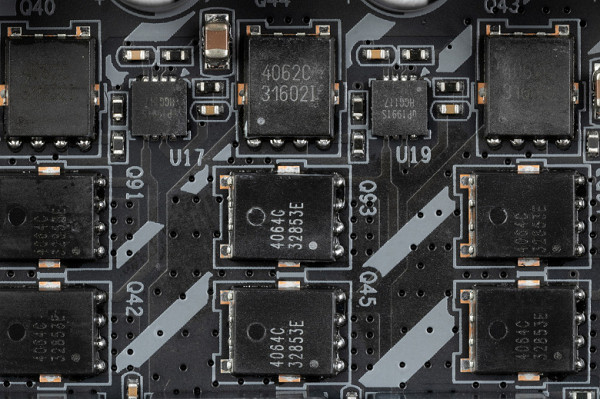
The VCore and iGPU power supply circuit is controlled by the RT3628 PWM controller from Richtek.

The VCCIO phase has its own PWM controller from uPI Semi.
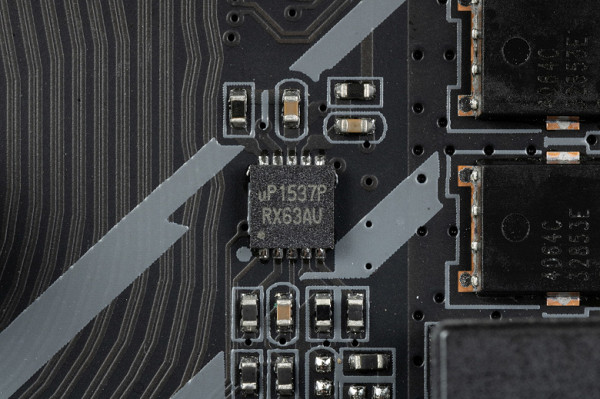
The VCCSA and DDR4 memory slots are powered by a much simpler single-phase design using SM4378/SM4364 MOSFET arrays from Sinopower.
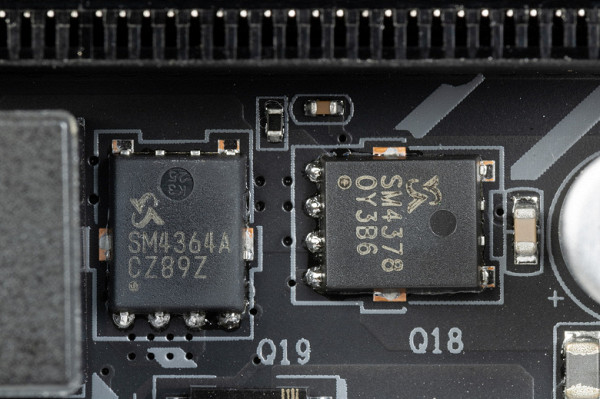
Now about cooling.
Not all potentially very hot elements have their own radiators.
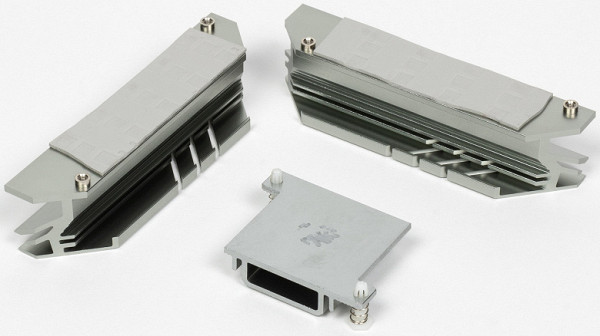
As we can see, the cooling of the chipset is organized separately from the power converters. The VRM section has its own two separate radiators.

But all M.2 slots do not have cooling.
Backlight
The board lacks backlighting itself and the ability to connect external backlighting.
Software for Windows
Afox does not have its own software.
BIOS settings
For budget motherboards, the company uses simplified BIOS/UEFI versions that do not support saving screenshots, so we cannot demonstrate all the settings visually.
To enter the settings when booting the PC, you need to press the Del or F2 key. The main menu contains standard options for managing the periphery, including settings for PCIe slots, SATA, M.2 and USB ports, as well as the operating parameters of the system chipset.
The monitoring section allows you to configure the operation of the fans, and the boot menu options remain familiar to BIOS. Overclocking here is limited to basic capabilities.
Performance (and overclocking)
Full configuration of the test system :
- motherboard Afox B760D4-MA-V2;
- Intel Core i9-14900K processor 4.5-5.8 GHz;
- TeamGroup RAM 32 GB (2×16) DDR4 (4000 MHz);
- TeamGroup MP44L NVMe PCIe 4.0 1TB SSD drive;
- Palit GeForce RTX 3050 StormX graphics card ;
- Power supply Super Flower Leadex Platinum 2000W (2000 W);
- LSS Sapphire Nitro+ S360-A AIO CPU Cooler ;
- TV LG 55Nano956 (55″ 8K HDR);
- USB — keyboard and mouse.
Software:
- Operating system Windows 11 Pro, 64-bit
- AIDA 64 Extreme
- 3DMark Time Spy CPU benchmark
- 3DMark Fire Strike Physics benchmark
- 3DMark Night Raid CPU benchmark
- HWInfo64
- OCCT v.13.1.0
- Adobe Premiere CS 2019 ( video rendering )
We launch everything in default mode. Then we load it with stress tests.

As you can see, the automatic overclocking of the most powerful Intel processor at the moment – the i9-14900K – turned out to be average, reaching 4.7/3.9 GHz. For such a simple motherboard, this is already a significant achievement, considering its extremely simple power supply system.
Although motherboards based on the B760 chipset are not designed for such top processors as the i9-14900K, we always test their power supply systems for durability, even when working with flagship CPUs.

Conclusions
The Afox B760D4-MA-V2 motherboard is designed for users who do not require high-performance hardware or an extensive set of ports and slots, but basic support for modern peripherals is important. The B760 chipset and simplified power system indicate that it is focused on mid-range processors and below. DDR4 support also makes it more affordable, since DDR4 modules are cheaper than DDR5, and no additional bandwidth is required.
At the time of publication of the review, this board cost about 7.5 thousand rubles, which makes it a budget option.
The board is equipped with 15 USB ports, including 6 USB 3.2 Gen1 ports, one long PCIe x16 slot with 16 PCIe 4.0 lanes from the processor, and one PCIe x1 slot. There are also 2 M.2 slots: one is connected directly to the processor via PCIe 4.0, the other is connected to the B760 chipset via PCIe 4.0. The board includes 3 SATA ports and 3 fan headers. Networking is limited to a 1 Gbps wired controller and a slot for a wireless adapter. There is no support for additional ARGB/RGB lighting devices.
